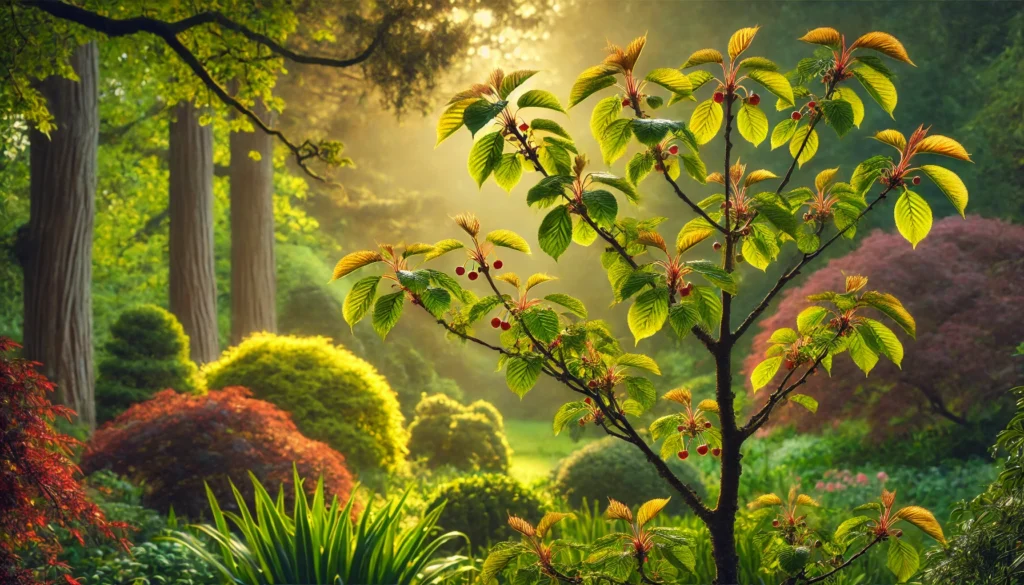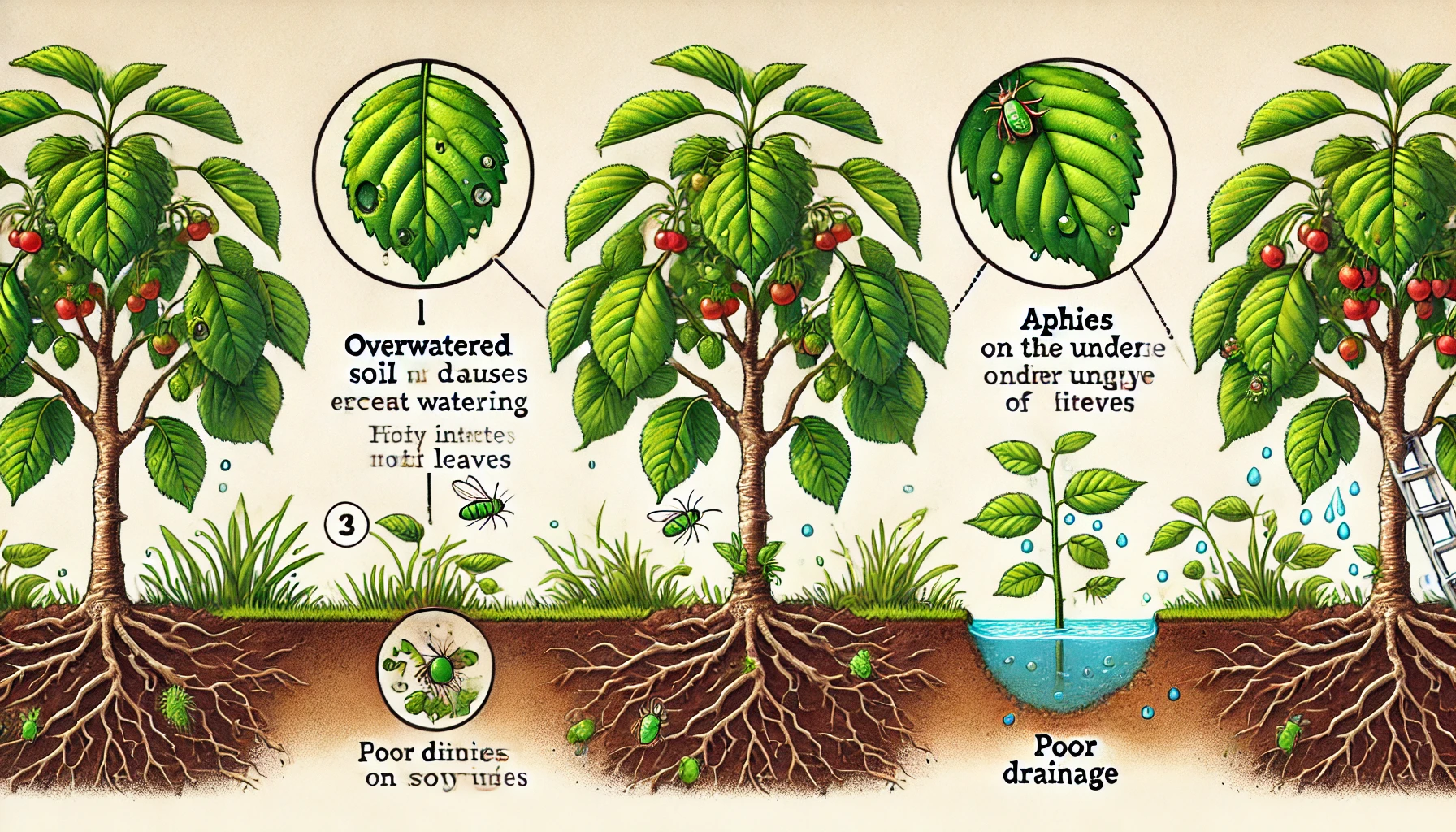
How to Diagnose and Treat Cherry Tree Yellow Leaves: Causes and Solutions
Cherry trees are known for their vibrant green foliage, but when those leaves start turning yellow, it’s a clear sign that something’s wrong. If you’ve noticed your cherry tree’s leaves losing their lush color, you may be wondering what’s causing the issue and how to fix it. In this article, we’ll show you how to diagnose and treat cherry tree yellow leaves, exploring the common causes behind this problem and providing effective solutions to restore your tree’s health. Whether it’s a watering issue, nutrient deficiency, or something more serious, we’ve got you covered with practical advice to get your tree back on track.
Table of Contents
ToggleCommon Causes of Cherry Tree Yellow Leaves 
Cherry trees are beautiful additions to any garden, but when their leaves turn yellow, it’s a sign that something might be wrong. Here are the most common causes for yellowing cherry tree leaves:
- Water Stress
Overwatering or underwatering can cause cherry tree leaves to turn yellow. Ensure the soil is well-drained and consistently moist, but not soggy. Inconsistent watering is often the culprit!
- Nutrient Deficiency
A lack of essential nutrients, particularly nitrogen, can cause yellowing leaves. Fertilize your cherry tree with a balanced, slow-release fertilizer to keep the soil nutrient-rich. - Pests and Diseases
Pests like aphids or fungal infections can weaken cherry trees, causing leaves to yellow. Regularly inspect the tree for pests and treat with appropriate methods if needed. - Poor Soil Drainage
Cherry trees need well-drained soil. If water accumulates around the roots, it can lead to root rot and yellow leaves. Improve drainage or plant the tree on a raised mound if necessary. - Environmental Stress
Extreme weather conditions such as drought, frost, or intense heat can stress a cherry tree, leading to yellowing. Ensure the tree is protected from harsh elements during extreme conditions.
By addressing these issues early, you can restore the health of your cherry tree and keep it thriving for years to come!
How to Diagnose Cherry Tree Yellow Leaves 
Yellowing leaves on your cherry tree can be caused by several factors. Here’s how you can diagnose the problem:
- Watering Issues
- Overwatering: If the soil is soggy or the roots are sitting in water, it can lead to yellow leaves. Cherry trees prefer well-drained soil.
- Underwatering: On the flip side, lack of water can cause stress and yellowing too. Ensure regular watering during dry spells.
- Nutrient Deficiency
- Nitrogen Deficiency: Yellowing leaves, especially older ones, may indicate a lack of nitrogen. Consider fertilizing with a balanced fertilizer.
- Iron Deficiency: If the yellowing starts between the veins, it could be a sign of iron deficiency. A foliar spray of iron chelate can help.

- Pests or Diseases
- Aphids or Spider Mites: Check for small pests on the underside of leaves. These can cause yellowing by sucking out plant fluids.
- Fungal Infections: Look for black spots or mold. Fungal diseases like cherry leaf spot can cause yellowing as well.
- Environmental Stress
- Extreme Weather: Sudden temperature changes or strong winds can cause stress, resulting in yellowing leaves.
- Improper Planting Location: Cherry trees need full sunlight. If planted in a shaded spot, the lack of sunlight could lead to leaf discoloration.
By carefully inspecting your tree for these signs, you can diagnose the cause of the yellowing leaves and take the right action to restore its health.
How to Treat Cherry Tree Yellow Leaves 

If your cherry tree has yellowing leaves, don’t worry! It’s a common issue that can usually be treated with some simple steps. Here’s how to help your cherry tree recover and stay healthy:
- Check Watering Needs
: Cherry trees don’t like to be overwatered or underwatered. Ensure the soil is well-drained and the tree receives about 1 inch of water per week. If the soil is too soggy or too dry, adjust your watering routine accordingly.

- Examine for Pests
: Yellowing leaves could be a sign of pest infestation. Look for aphids, caterpillars, or mites. If you spot any, use insecticidal soap or neem oil to eliminate them.
- Fertilize Properly
: Too much or too little fertilizer can cause yellow leaves. Use a balanced fertilizer, especially one high in potassium, which helps improve leaf color and overall tree health. Apply it in early spring before new growth starts.
- Check for Disease
: Fungal infections like leaf spot or rust can also cause yellowing. Remove affected leaves and consider applying a fungicide if necessary. Ensure the tree has proper air circulation to reduce disease risk.
- Ensure Proper Sunlight
: Cherry trees need at least 6 hours of direct sunlight each day. If your tree is in a shaded area, consider relocating it to a sunnier spot.
By following these steps, you can restore your cherry tree to its vibrant self! If yellow leaves persist, it’s always a good idea to consult an arborist for a closer look.
Preventing Yellow Leaves in the Future 
Once you’ve addressed the causes of yellow leaves on your plant, it’s essential to take steps to prevent them from recurring. Here are some easy-to-follow tips to keep your plant healthy and vibrant:
- Water Properly
: Avoid overwatering and underwatering. Ensure the soil is moist but not soggy. Use a well-draining pot to prevent water from accumulating at the bottom.
- Fertilize Regularly
: Use a balanced fertilizer to provide essential nutrients. Follow the recommended schedule to avoid nutrient deficiencies, which can lead to yellow leaves.
- Ensure Proper Light
: Place your plant in an area with the right amount of sunlight. Most plants need bright, indirect light. Too little or too much sunlight can stress the plant and cause yellowing.
- Maintain Ideal Temperature
: Keep your plant in a location with a consistent temperature. Avoid drafts or sudden temperature changes that can harm the plant.

- Check for Pests
: Regularly inspect your plant for pests like aphids or spider mites. These can damage leaves and contribute to yellowing.
- Repot When Necessary
: If your plant outgrows its pot, repot it into a larger container with fresh, nutrient-rich soil. This prevents root-bound conditions that could stress the plant.
By following these simple guidelines, you can help prevent yellow leaves from appearing and keep your plants thriving for years to come!
 Conclusion
Conclusion
In conclusion, how to diagnose and treat cherry tree yellow leaves requires careful attention to the underlying causes, whether it’s due to watering issues, nutrient deficiencies, pests, or environmental stress. By properly diagnosing the problem and applying the right treatment, you can restore your cherry tree’s health and prevent further yellowing.

Regular maintenance, such as proper watering, fertilization, and pest control, is key to preventing yellow leaves in the future. With a little knowledge and proactive care, you can ensure your cherry tree remains healthy, vibrant, and free of yellowing leaves for seasons to come.
Frequently Asked Questions(FAQ)
What causes yellow leaves on cherry trees?
Yellow leaves on cherry trees can be caused by several factors, including overwatering, underwatering, nutrient deficiencies (especially nitrogen or iron), pest infestations, or environmental stress such as extreme temperatures. It’s important to identify the underlying cause to treat it effectively.
How do I know if my cherry tree is overwatered or underwatered?
Overwatered trees often show yellow leaves with a soft, mushy feel, along with wet soil that doesn’t drain well. Underwatered trees typically show yellowing leaves with dry, brittle edges and soil that’s too dry. Proper watering and good drainage are key to keeping your tree healthy.
How can I treat yellow leaves caused by nutrient deficiency?
If yellowing is due to a nutrient deficiency, such as nitrogen or iron, applying a balanced fertilizer or a specific supplement (e.g., iron chelates) can help restore the tree’s color. Be sure to follow the manufacturer’s guidelines to avoid over-fertilizing.
Can pests cause cherry tree leaves to turn yellow?
Yes, pests like aphids, scale insects, and mites can damage cherry trees, leading to yellowing leaves. These pests suck sap from the leaves, causing them to discolor and weaken. Inspect your tree for visible insects and use appropriate pest control methods, like neem oil or insecticidal soap.
Is it normal for cherry tree leaves to turn yellow in the fall?
Yes, it is natural for cherry trees and many other deciduous trees to turn yellow and fall off in the autumn as part of their seasonal cycle. If the yellowing happens outside of fall, it’s a sign of an underlying issue.
How often should I fertilize my cherry tree to prevent yellow leaves?
Fertilize your cherry tree in early spring when new growth starts and again in late summer to support its health through the growing season. Over-fertilizing can lead to other issues, so follow the recommendations based on your tree’s specific needs.
Can I prune yellow leaves off my cherry tree?
Yes, you can prune yellowing or diseased leaves to improve airflow and prevent the spread of infection. Be sure to use sterilized pruning tools to avoid spreading pathogens, and remove all pruned material from the area.
How can I prevent yellow leaves on my cherry tree in the future?
Prevent yellow leaves by maintaining proper watering habits, fertilizing your tree with the right nutrients, and protecting it from pests and diseases. Regular inspections and early intervention will help keep your cherry tree healthy and vibrant.






